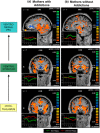Mothers with substance addictions show reduced reward responses when viewing their own infant's face
- PMID: 28746733
- PMCID: PMC5763911
- DOI: 10.1002/hbm.23731
Mothers with substance addictions show reduced reward responses when viewing their own infant's face
Abstract
Maternal addiction constitutes a major public health problem affecting children, with high rates of abuse, neglect, and foster care placement. However, little is known about the ways in which substance addiction alters brain function related to maternal behavior. Prior studies have shown that infant face cues activate similar dopamine-associated brain reward regions to substances of abuse. Here, we report on a functional MRI study documenting that mothers with addictions demonstrate reduced activation of reward regions when shown reward-related cues of their own infants. Thirty-six mothers receiving inpatient treatment for substance addiction were scanned at 6 months postpartum, while viewing happy and sad face images of their own infant compared to those of a matched unknown infant. When viewing happy face images of their own infant, mothers with addictions showed a striking pattern of decreased activation in dopamine- and oxytocin-innervated brain regions, including the hypothalamus, ventral striatum, and ventromedial prefrontal cortex-regions in which increased activation has previously been observed in mothers without addictions. Our results are the first to demonstrate that mothers with addictions show reduced activation in key reward regions of the brain in response to their own infant's face cues. Hum Brain Mapp 38:5421-5439, 2017. © 2017 Wiley Periodicals, Inc.
Keywords: addiction; dopamine; infant; maternal; oxytocin; reward.
© 2017 Wiley Periodicals, Inc.
Figures





References
-
- Afonso VM, Sison M, Lovic V, Fleming AS (2007): Medial prefrontal cortex lesions in the female rat affect sexual and maternal behavior and their sequential organization. Behav. Neurosci 121:515–526. - PubMed
-
- Afonso VM, King S, Chatterjee D, Fleming AS (2009): Hormones that increase maternal responsiveness affect accumbal dopaminergic responses to pup‐ and food‐stimuli in the female rat. Horm Behav 56:11–23. - PubMed
-
- American Psychiatric Association (2000): Diagnostic and Statistical Manual of Mental Disorders, 4th ed., text rev. Washington, DC: American Psychiatric Association.
-
- Atzil S, Hendler T, Zagoory‐Sharon O, Winetraub Y, Feldman R (2012): Synchrony and specificity in the maternal and the paternal brain: Relations to oxytocin and vasopressin. J Am Acad Child Adolesc Psychiatry 51:798–811. - PubMed
Publication types
MeSH terms
Grants and funding
LinkOut - more resources
Full Text Sources
Other Literature Sources
Medical

